Nuclear era. Part 3
USSR and Russia
Contrary to the prevailing stereotype, work to create a nuclear weapons in the USSR began long before the Soviet leadership became aware of the "Manhattan Project" in the United States. Back in January, 1922, on the initiative of Academician V.I. Vernadsky in our country the Radium Institute was established, here in 1937, the centrifugal method for the separation of uranium isotopes was first used. Pre-war research in the field of nuclear physics was also carried out at the Ukrainian Physical-Technical Institute and the Institute of Chemical Physics. At the end of the 30s, Soviet scientists independently theoretically substantiated the possibility of a uranium fission chain reaction. In 1940, the staff of the Kharkov Institute of Physics and Technology proposed the project of the first Soviet atomic bomb.
Unfortunately, at that time this proposal did not meet with understanding on the part of the authorities, and the technical implementation of such a project required enormous expenditures with unclear prospects at that time, but in 1941, all surveys conducted in the USSR in this area were classified. The outbreak of the Great Patriotic War greatly slowed down the research of nuclear physicists, the majority of scientists switched to topics more relevant to the front. Nevertheless, work on this issue continued even in the most difficult time for our country. After receiving intelligence on the development of nuclear weapons in the United Kingdom and the United States, the Uranium Commission was established at 1942 at the USSR Academy of Sciences. In February, 1943 was adopted by the State Defense Committee on the commencement of practical work on the creation of a uranium bomb.
In the 1945 year, shortly after the completion of the assembly of the first nuclear charge in the United States, Soviet intelligence was able to obtain a detailed description of its structure. The characteristics of the first test explosion at the White Sands test site, near the city of Alamogordo in New Mexico, were also transferred to the USSR. Because of this, the acquisition of the US “nuclear baton” did not come as a surprise to I.V. Stalin.
Shortly after the nuclear bombing of Japanese cities, a resolution of the State Defense Committee signed by I.V. Stalin on the establishment of the Special Committee, which was entrusted with the leadership of all work in the nuclear field. A committee with broad powers was headed by L.P. Beria, who proved himself as a talented organizer. The end of the war allowed freeing up production facilities and human resources and directing them to the creation of the Soviet atomic bomb. Along the way, the tasks of creating and setting up production of special alloys, materials, instruments and equipment were solved. Uranium ore came from the countries of Eastern Europe and the Leninabad Mining and Chemical Combine in Tajikistan. In the Southern Urals, construction began on a plant to obtain weapons-grade plutonium, and in the Middle Urals, a plant for the diffusion enrichment of uranium. At the end of 40-x - the beginning of 50-x were laid scientific and production nuclear centers, which later became "Arzamas-16" (Sarov) and "Chelyabinsk-70" (Snezhinsk).
At the cost of tremendous efforts and considerable sacrifices, our country managed to eliminate its lag in the nuclear field. During 1946-1947, the technical details, the design of the main units were worked out and the drawings of the plutonium and uranium bombs were approved. In August of the year 1949, after receiving parts from high-purity plutonium from a chemical and metallurgical plant, the assembly of the first Soviet nuclear charge began.
29 August 1949 ended the US monopoly on the possession of nuclear weapons. The test nuclear explosion was successfully carried out at the test site in the Semipalatinsk region of Kazakhstan. The power of the first Soviet stationary nuclear explosive device was within 22 kt. According to its characteristics and constructively, the Soviet plutonium RDS-1 bomb was close to the American “Fat Man”, but when it was created, components and equipment of Soviet development were used. In addition, it differed more perfect in aerodynamic terms, the body shape.
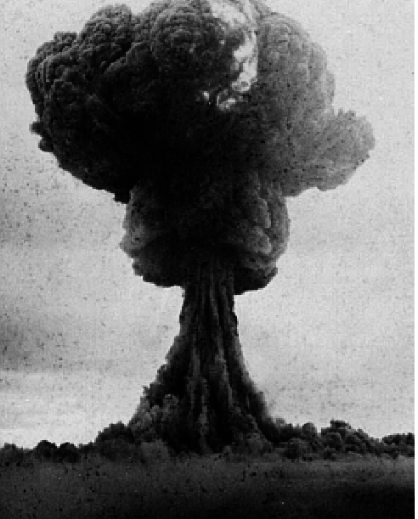
The methodology for conducting nuclear tests in Kazakhstan is also largely based on the American experience. The nuclear charge was set on top of the 37-meter steel tower. In preparation for the tests, various fortifications and residential buildings were built in the district; spans of railway and highway bridges were installed.
In order to test the vulnerability to the damaging factors of nuclear weapons at different distances from the point of the explosion, weapons were installed, aviation, automotive and armored vehicles. Experimental animals were placed in trenches and shelters.
The Soviet leadership tried to conceal the fact of nuclear testing until a sufficient number of atomic bombs were accumulated in the USSR. It was believed that information about the successful testing of an atomic bomb in the USSR could provoke the United States to launch a preemptive nuclear strike. However, it was not a long time to keep secret the fact of conducting a nuclear test. Air samples taken at the beginning of September by an American B-29 aircraft near Kamchatka revealed the presence of radioactive isotopes in the atmosphere, which could only appear as a result of a nuclear explosion conducted in the Soviet Union. It took the American leadership nearly a month to reflect on this shocking fact. Prior to that, the United States believed that before the 1953, the atomic bomb in the USSR would not appear. Only 23 of September, President G. Truman made a public statement on nuclear testing in the USSR.
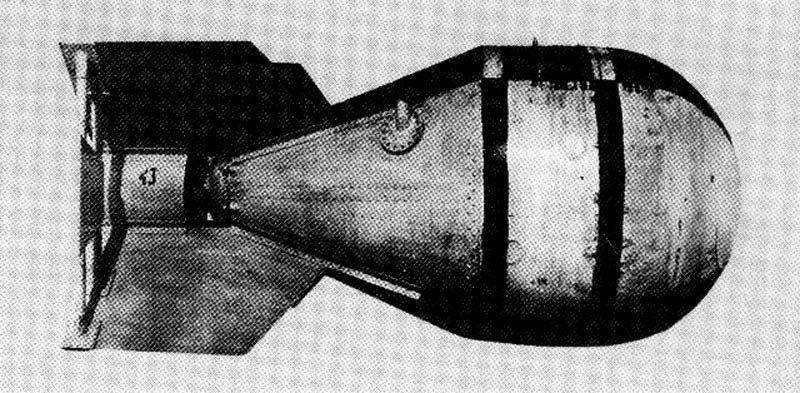
In the 1951, in the USSR, 29 RDS-1 atomic bombs were manufactured, but these were still quite “raw”, requiring lengthy preparation for using the device. To saturate parts of long-range aviation, atomic bombs with acceptable service and operational characteristics were needed.
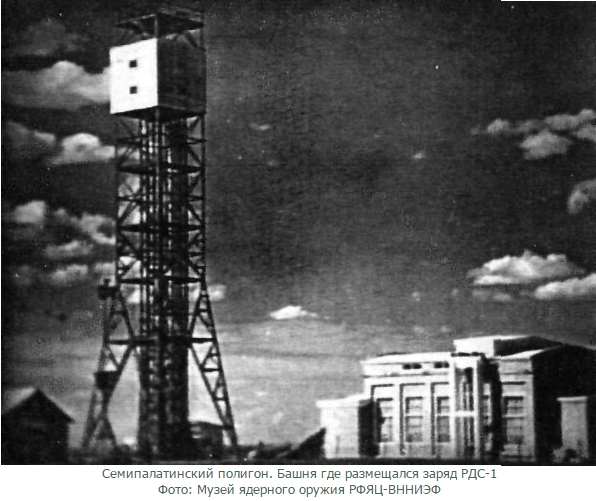
September 24 The 1951 of the Semipalatinsk nuclear test site successfully tested an RDS-2 bomb. In the new bomb, a number of new constructive-technical solutions were worked out, and its power was almost doubled compared to the RDS-1. The nuclear charge this time already in the body of the bomb was, as in the first case, installed on the 37-meter tower, but the signal to activate the detonation machine came from a Tu-10 bomber flying at an altitude of 4 km.
In total, the USSR collected 59 RDS-2. Part of the RDS-2 bombs obtained by reworking the RDS-1. Another RDS-2 atomic bomb was detonated on 14 on September 1954 at the Totsk training ground during tactical military exercises with real-world use of nuclear weapons. During the exercise, the 32 bomb with a height of 8000 m dropped the Tu-4 bomber. The bomb exploded at an altitude of 350 m with a deviation from the aiming point of 250 m.
These exercises involved 45000 military personnel, led by Marshal G.K. Zhukov. The purpose of the exercise was to test the impact of a nuclear explosion on a previously prepared defense site, and also to work out measures to protect and deactivate personnel and military equipment in conditions as close as possible to combat.
Currently, the level of radioactivity in the area where the explosion occurred, is slightly different from the natural background values. In place of which a bomb was exploded, in memory of the “atomic exercises” that took place here, during which many servicemen received significant doses of radiation, a memorial sign was set.
October 18 1951 at the Semipalatinsk test site for the conditional goal was carried out test dumping of an atomic bomb RDS-3 42 kt power. It was the first real atomic bomb dump in the USSR from a bomber. Tests have shown that with an air explosion at a height of several hundred meters, the level of radioactive contamination of a locality is more than 100 times less than at ground level.
A distinctive feature and difference of the RDS-3 from previous models was the use of a combined core filling in the 1: 3 ratio (25% plutonium to 75% uranium), which saved scarce plutonium and increased the number of atomic bombs produced in the Soviet Union.
The first Soviet atomic bomb, the carriers of which could be front-line bombers, became RDS-4 with a beautiful female we have "Tatiana". Its successful tests were carried out on 23 August 1953, when the atomic bomb of 1200 kg mass was dropped from the Il-28 jet bomber flying at an altitude of 11 km. The power of the explosion at the height of 600 m amounted to 28 kt.
Besides IL-28, other front and long-range aircraft could be carriers of the RDS-4. But the bomb itself, for several reasons, was not exploited for long. In production, it was soon replaced by a much lighter and more compact 8У49 "Natasha" with a power of 40 kt. The weight of the bomb has been reduced to 450 kg. Initially, “Natasha” could be hung up under the low-volume bombers Yak-26, but later the list of carriers was significantly expanded.
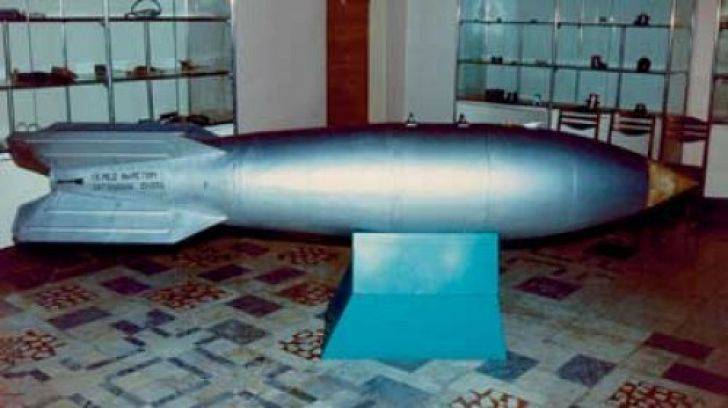
Back in 1946, Soviet scientists began to work on the creation of a thermonuclear bomb. Unlike the first American stationary thermonuclear device, which weighed tens of tons and measured the size of a three-story house, the Soviet thermonuclear charge was initially created in a version suitable for practical use. For the first time in world practice, the “dry” thermonuclear fuel was used in a two-stage RDS-6 bomb, which significantly reduced its size and made it possible to store it for a long time.
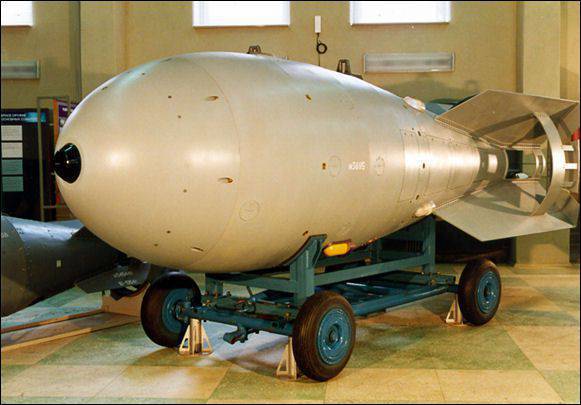
The RDS-6 bomb passed 12 August 1953 tests at the Semipalatinsk nuclear test site. The explosion occurred at an altitude of 30 meters, on the site of a specially built tower. The TNT equivalent was about 400 kt. Brick buildings were destroyed within 4 km, and the span of a railway bridge weighing 100 and installed in 1 km from the point of the explosion was dropped almost 200 meters. Due to the fact that the explosion was almost ground, part of the landfill was heavily contaminated with radiation. Until now, the radiation background in this place is much higher than normal.
Information in open sources about whether the RDS-6 was adopted, could not be found, but it is known that the weight and size models were dropped from long-range aircraft bombers during training flights. The dimensions of the RDS-6 thermonuclear bomb allowed it to be placed in the bomb bay of the Tu-16 bomber. In an improved version of the bomb, lithium-6 deuteride should have been used instead of deuterium, which made it possible to bring its power to 1 MT.
The first thermonuclear bomb dropped from the Tu-16 bomber in the USSR was the RDS-27. By design, it was very similar to RDS-6с. The power of the test explosion 6 produced on November 1955 was 250 kt.
The two-stage thermonuclear bomb, in which the 1 MT energy release threshold was exceeded, was RDS-37. The estimated amount of energy released was in the 3 area of MT. However, for security reasons, the power of the charge during the tests limited 1,6 MT.
The first test reset attempt, scheduled for November 20 1955, was unsuccessful. Due to the loss of visibility and the out-of-sight radar sight, the Tu-16A bomber with a suspended hydrogen bomb was forced to return to the airfield. Thus, the first in the USSR, although not planned, landing of a bomber with thermonuclear weapons on board took place.
A retry of 22 on November 1955 of the year was successful. The RDS-37 thermonuclear bomb exploded at an altitude of 1500 meters, at the time of the explosion the bomber was at a safe distance of 15 km.
As a result of the explosion, an unprecedented amount of energy was released. Observers located at a distance of 35 km, felt a strong influx of heat, and the sound of the explosion was similar to the close thunderclap. In a radius of up to 200 km, windows flew out of the houses, two people died as a result of landslides and partial destruction of buildings, more than thirty people were injured of varying degrees of severity.
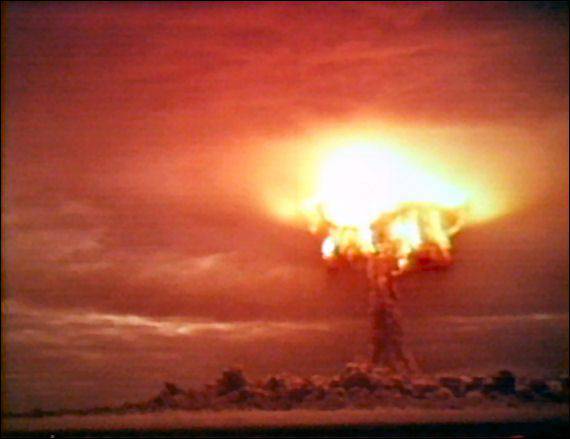
At the Semipalatinsk nuclear test site from 1949 to 1989. produced 616 nuclear explosions. Including 125 atmospheric tests (26 ground, 91 air, 8 high altitude) and 343 underground explosions (of which 215 in galleries and 128 in wells).
As a result of large-scale releases of radioactive substances, the territory of the landfill in some places is still heavily polluted, and the radiation background reaches 10-20 millirentgen per hour. Despite this, in the areas adjacent to the landfill, economic activity is conducted. After the collapse of the USSR, the landfill was left almost unguarded, and its areas were used for cattle grazing. The local population actively collected scrap metal contaminated by radiation from nuclear tests. Until 2006, the territory of the nuclear test site was not fenced and in no way marked on the ground.
In 2012, a secret, joint operation to collect and seize fissile materials suitable for building nuclear weapons and dirty bombs took place at the site. Representatives of Russia, Kazakhstan and the United States took part in the operation. The event was financed by the American side. During the operation, about 200 kg of radioactive material, mainly plutonium, was collected. According to expert estimates, this plutonium would be enough to create several dozen nuclear bombs. According to unconfirmed data, at the site in the wells there are still unused nuclear charges.
Another major Soviet nuclear test site where air, underwater, surface, ground and underground nuclear explosions were carried out was a nuclear test site on the Novaya Zemlya archipelago. The landfill occupied about half of the entire island. The first underwater nuclear test conducted here is September 21 1955.
In 1961, the AN602 thermonuclear bomb (RDS-202), also known as “Tsar Bomb” or “Kuzkina Mother”, with a TNT equivalent of MTN was blown up on the test site of the Dry Nose Peninsula. Initially, the design capacity of the bomb was 58 MT, but for security reasons it was reduced by half.
To test the AN602 bomb weighing more than 26000 kg and 8000 mm in length, a specially prepared Tu-95В bomber was isolated, on which the bomber hatch flaps were dismantled. Otherwise, the bomb was simply impossible to hang under the plane.
The thermonuclear bomb actually turned out to be ready for testing already in 1959, and several inert models were dropped from the Tu-95В during training tasks. But N.S. Khrushchev, not wanting to aggravate relations with the United States, did not give the command to begin full-scale tests.
The situation has changed after the new round of the Cold War. Khrushchev, in his report 17 October 1961, at the XXII Congress of the CPSU announced the upcoming tests of a powerful hydrogen bomb. Thus, nuclear weapons once again became an element of military-political pressure in the “cold war”.
October 30 1961, the Tu-95В, with a bomb aboard taking off from the Olenya airfield in the Murmansk region, headed for Novaya Zemlya. In 11 hours 33 minutes by command of a barometric sensor, a bomb dropped from 10500 m exploded at 4000 m. The fireball during an explosion exceeded the radius 4 km, it was prevented from reaching the ground surface by a powerful reflected shock wave that threw the fireball off the ground.
A huge cloud formed as a result of the explosion reached an altitude of 67 km, the diameter of the “mushroom stem” is estimated at 95 km. With a shock wave, the carrier plane dropped to a height of 8000 m, and for some time after the explosion, the Tu-95В was out of control.
Unlike the American test of the hydrogen bomb Castro Bravo, the explosion of the Kuz'kin Mother on Novaya Zemlya was relatively “clean.” The test participants arrived at the point above which a thermonuclear explosion occurred, after two hours already, the radiation level in this place did not pose a great danger. This was affected by the design features of the Soviet bomb, as well as the fact that the explosion occurred at a sufficiently large distance from the surface.
1955 to 1990 135 test nuclear explosions were performed at the test site. These include 87 in the atmosphere, including 84 air, 1 ground, 2 surface, 3 underwater and 42 underground. The coastal waters of the Novaya Zemlya archipelago prior to the start of the 90's were used to discharge liquid and dump solid radioactive waste. Currently, Novaya Zemlya is engaged in research in the field of nuclear weapons (the object is Matochkin Shar). It was reported that, if necessary, underground nuclear tests on the island can be resumed, but this will happen only if the United States leaves the moratorium on nuclear tests. In the meantime, our nuclear specialists are costing mathematical models based on the experience of those who have been tested. The use of supercomputers to simulate the processes occurring during uncontrolled nuclear chain reactions, saves resources and improves safety.
This year, in the New Earth, the anti-aircraft cover lost at the beginning of 90's was restored. At the southern tip of the island, the positions of the modernized C-300PM2 positions are deployed - this demonstrates the importance our military-political leadership attaches to the landfill and defense of the northern borders.
Before the introduction of the moratorium in the USSR, 969 explosions of nuclear devices were carried out. In addition to the Semipalatinsk and the landfill on Novaya Zemlya, from the middle of the 50-x to the beginning of the 60-x at the Kapustin Yar test site at least 11 test nuclear explosions in the air were carried out.
In addition to military nuclear tests in the USSR, as well as in the United States, "peaceful" nuclear explosions were carried out for research and national economic purposes. The geography of these explosions was quite wide, they affected almost the entire territory of the USSR from the east to the west, from Yakutia to Turkmenistan and Ukraine. Only in Yakutia, seven nuclear charges were blown up in 70. The champion in this area was the Kazakh SSR; here, 80 “peaceful” nuclear explosions thundered around.
With the help of nuclear explosions, they tried to create artificial underground cavities for the storage of oil, gas and the burial of toxic wastes, to silence emergency oil and gas wells, to erect dams and artificial reservoirs. About a third of the “peaceful” explosions were made for seismic sounding. Some explosions were abnormal and there was a leak of radioactive substances after them.
The explosion in Kazakhstan, produced by 15 in January 1965 of the year during the implementation of the Chagan project, was best known. His goal was to create an artificial lake. Unlike the similar American project “Storaks Sedan”, the yield of radioactive products in the 170 CT explosion was several times smaller. After the explosion, a crater with a depth of 100 meters and a diameter of 430 meters remained.
Even taking into account that the charge was made as “clean” as possible, the radiation contamination during the release of 10,3 million tons of soil was significant. The radioactive cloud has affected 11 settlements with a population of more than 2000 people.
In the spring of 1965, the channel of the Chagan River was connected by an artificial channel with a funnel, as a result of which a reservoir was formed with an area of mirror 0,14 km², volume 7 million m³. The level of radioactive contamination after six months at the edges of the funnel reached 150 milli-rentgen / hour. Currently, the level of radiation around the lake in some places reaches 2-3 milli-roentgen / hour, and it is not safe to use its water for commercial purposes.
Until the second half of the 60, long-range bombers were the main Soviet means of delivering fusion warheads to the US. Given that the airspace of North America was controlled by a continuous radar field and was protected by numerous fighter-interceptors and anti-aircraft missile systems, in the event of a war, the probability of a breakthrough of Soviet bombers was small.
The situation began to change after the creation of intercontinental ballistic missiles with megaton combat units in the USSR. And although the accuracy of hitting the first Soviet ICBMs was small, the circular probable deviation of several kilometers with the power of a nuclear warhead in 3 Mt in the case of use in large American cities did not matter much. At the same time, the first domestic ICBMs (P-7, P-16, P-9А) required a lot of time to prepare for launch.
At the same time, in 60, strategic missile submarines of the 658 / 658М avenue with ballistic missiles on board took up combat patrols. The Soviet boats in a number of parameters were inferior to the American nuclear submarine missile carriers “George Washington”, but they fulfilled their role in nuclear deterrence at a certain stage.
For a long time, the United States had a significant superiority over the USSR in the field of strategic nuclear weapons and means of delivery. In addition, the Soviet Union was surrounded by a large number of US military bases, and the attempt to deploy medium-range missiles in Cuba almost led to the beginning of a nuclear war.
Parity with the United States was reached in the middle of the 70s. With the P-36, UR-100, RT-2 ICBMs on duty, the US attempts to achieve unilateral nuclear superiority were finally buried. At the price of tremendous efforts in the USSR, a powerful grouping of the Strategic Missile Forces was deployed, not inferior in terms of the quantitative and qualitative composition of the American grouping of intercontinental ballistic missiles.
Nuclear-nuclear parity for a long time implied that the United States and Russia did not seek to acquire the possibility of a first disarming strike, maintaining balance. Since the destabilization of equilibrium and the achievement of strategic superiority can provoke the other side to launch a preemptive nuclear strike.
The destabilizing factor is the US withdrawal from the ABM Treaty and the beginning of the deployment of the National Missile Defense System. One way or another, our country will have to answer this challenge, otherwise it is fraught for us with a complete loss of the ability to make independent political and economic decisions.
At present, the strategic nuclear forces of Russia are based on the mine and mobile missile systems of the Strategic Missile Forces: Р-36М2, УР-100Н УТТХ, РТ-2ПМ2 "Topol-М", PC-24 "Yars". As of the year 2014, there was an 390 MBR in the Strategic Missile Forces capable of delivering nuclear charges to the 1190.
In the very near future, deliveries to the troops of the latest mobile missile system PC-26 "Rubezh" should begin. It is a further option for the development of a mobile soil missile complex with an intercontinental ballistic missile - RS-24 "Yars". It is expected that the Irkutsk Guards RVSN will be the first to receive new strategic missiles.
In the next 10 years, the service life of the mine-based missiles R-36М2, UR-100Н УТТХ that were made in the Soviet Union, will expire. Shortly before the collapse of the USSR, the heavy P-36М3 ICBM was successfully tested, but due to well-known events, it was not mass-produced. However, due to the US withdrawal from the ABM Treaty, there is currently an urgent need for such a rocket. As it became known, work is underway in Russia to create a new 100-tonne silo-based liquid rocket. According to the plans, the new heavy ICBM, known as "Sarmat", should be put into service within 10 years.
By 2005, in our country all the combat railway missile systems RT-23 UTTH “Molodets” were destroyed and destroyed. Time has shown the fallacy of this hasty decision. Not so long ago, the intention to develop and adopt a new BZHRK with ICBM RS-26 "Frontier" was announced.
The Russian Navy has 11 SSBNs of the 667BDRM Dolphin Ave., 667BDR Kalmar Ave. and 955 Borey Ave. Their missiles are capable of carrying around 500 warheads. In the near future, it is expected to put into operation another boat, 955 Ave.
Until recently, the basis of the Russian marine component of the nuclear triad was 9 SSBNs, Project 667BDRM and Project 667BDR. The latest strategic submarine missile carrier, pr. 667BDRM K-407 Novomoskovsk the fleet in 1990. Other boats of this project were built in the mid - late 80s. One boat of this project - K-64 "Moscow Region", which entered service in 1986, was converted into a carrier for deep-sea underwater vehicles BS-64.
Each of the six boats of the 667BDRM Ave. is armed with 16 R-29RMU2 “Sineva” liquid-propellant ballistic missiles or “P-29RMU2.1“ Liner ”, on which up to 10 warheads with individual guidance can be installed. The range of the P-29RMU2.1 missiles ranges from 8300 to 11500 km, depending on the weight of the warhead. According to American naval analysts, missile salvo SSBN Ave 667BDRM, in the event of a strike on major American cities, is on average capable of destroying about 6 million Americans. All boats of the 667BDRM Ave are concentrated in the Northern Fleet, and are expected to remain in service until the 2020 of the year.
So far, formally, the Pacific Fleet has three SSBNs of the 667 BDR Avenue with the 16 SLBM R-29Р with a launch range in the monoblock version up to 8000 km. It is expected that in the near future the boats of the pr. 667 BDR, built in the 1980-1982, will be replaced on the Pacific Fleet by submarine rocket carriers of the 955 av. A total of 7 SSBNs of 955 Ave and 955A are planned with the 16 SLBM of the P-30 "Bulava".
The aviation part of the Russian nuclear triad includes the X-NUMX bombers Tu-14 and 160 Tu-2 and 160 Tu-40 bombers. Aircraft of long-range aviation are deployed at the Engels airbase in the Saratov region and at the Ukrainka airbase in the Amur region. Long-range bombers are capable of carrying cruise missiles in addition to free-falling nuclear bombs as part of the tasks of strategic deterrence. In the future, it is planned to resume production of the upgraded Tu-95М160.
Currently, Russian long-range aviation does not fly with nuclear weapons on board. At the same time, as recent events in Syria have demonstrated, Russian long-range aviation is a very flexible tool and is capable of delivering effective high-precision strikes by air-based cruise missiles not in nuclear equipment.
At the expanded collegium of the Ministry of Defense of the Russian Federation, December 11 of December 2015, Defense Minister S. Shoigu reported to the country's leadership that the share of modern weapons in strategic forces is 51%. This year, the 35 ICBM was put into service, the 2 SSBN of 955 Ave was put into the permanent readiness forces, the upgraded bomber 9 was transferred to XNUMX long-range aviation.
In the field of tactical nuclear weapons, Russia has a significant advantage over the United States. According to foreign expert estimates, our armed forces have approximately 2000 tactical nuclear weapons. This includes combat units for A-135 anti-missile systems, anti-aircraft missiles, torpedoes, depth charges, operational-tactical missile systems, and tactical nuclear bombs for Su-24М, Su-34 and Tu-22М3 bombers. Most of the Russian tactical nuclear charges are stored at the facilities of the nuclear-technical divisions of the 12-GUMO and will be supplied to the troops during the “threatened period”. But testing the delivery of Russian TNW to troops and preparation for combat use takes place annually.
Since its inception, nuclear weapons have played an important role in ensuring the security of our country, being a powerful deterrent to potential aggressors. Largely due to the presence of nuclear weapons in the Russian armed forces, our country has managed to maintain independence and territorial integrity and has not been subjected to violent "democratization."
Based on:
Nuclear tests in the USSR. Volume I. Sarov. RFNC-VNIIEF
Nuclear tests in the USSR. Volume II. Sarov. RFNC-VNIIEF
https://translate.googleusercontent.com
http://www.vniief.ru/vniief/museum/weapon/weapon2.html
http://nvo.ng.ru/armament/2005-06-10/1_bombs.html
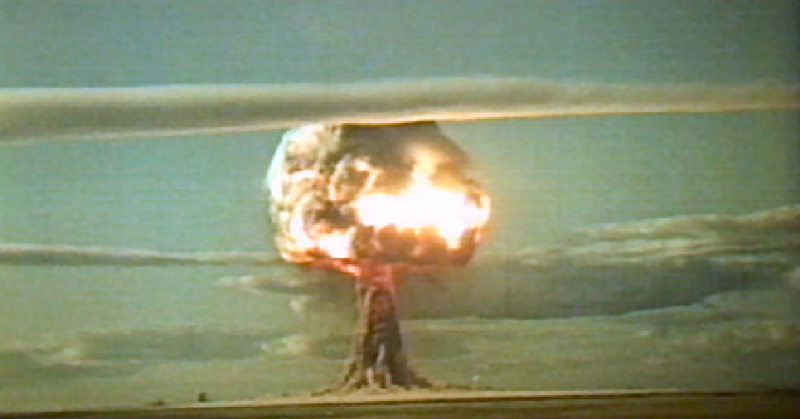
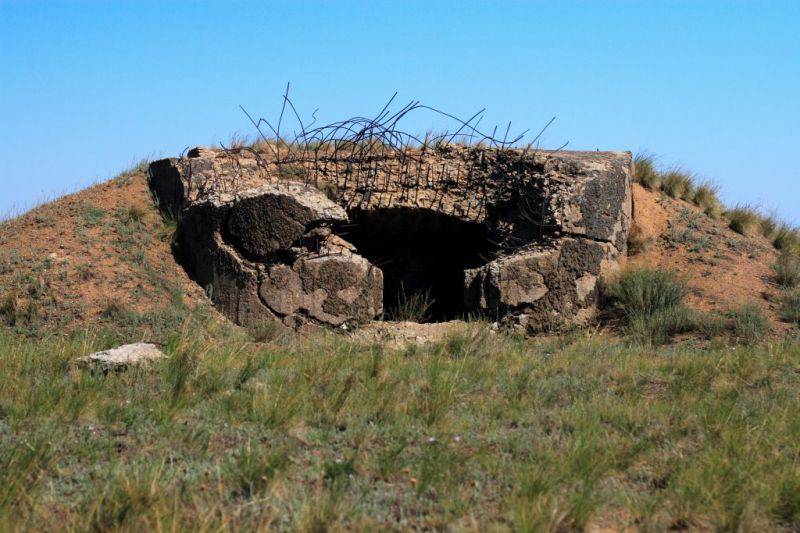
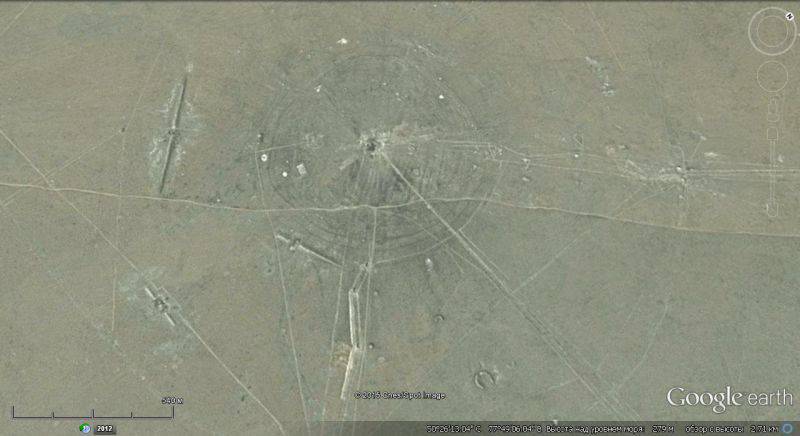
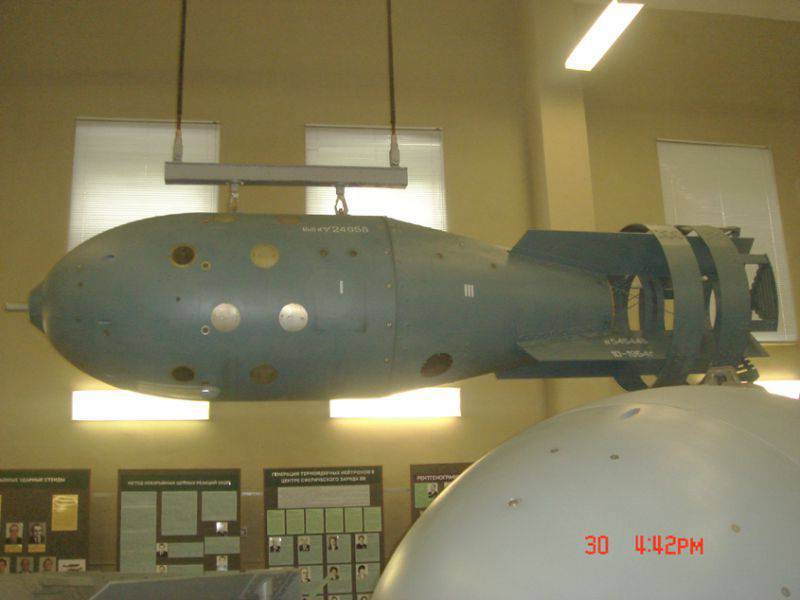
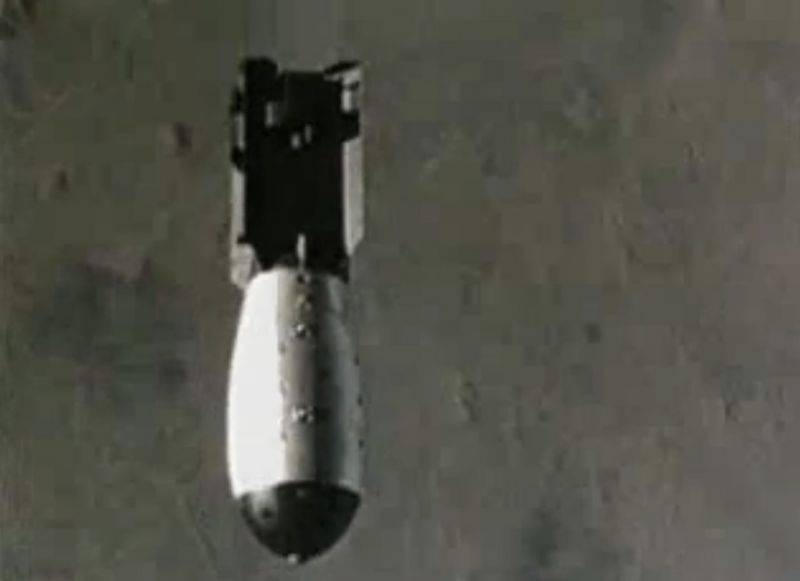
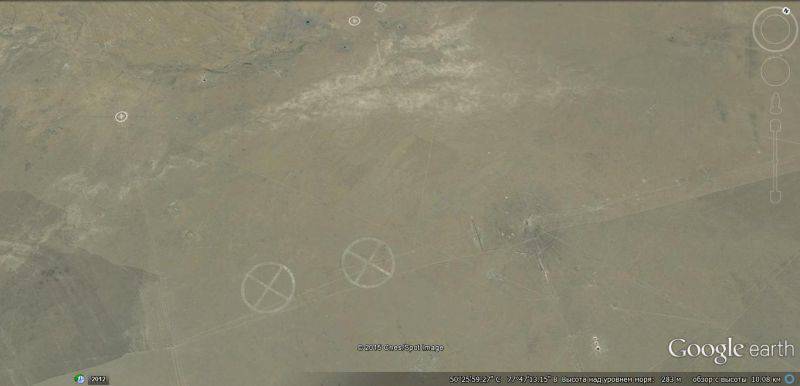

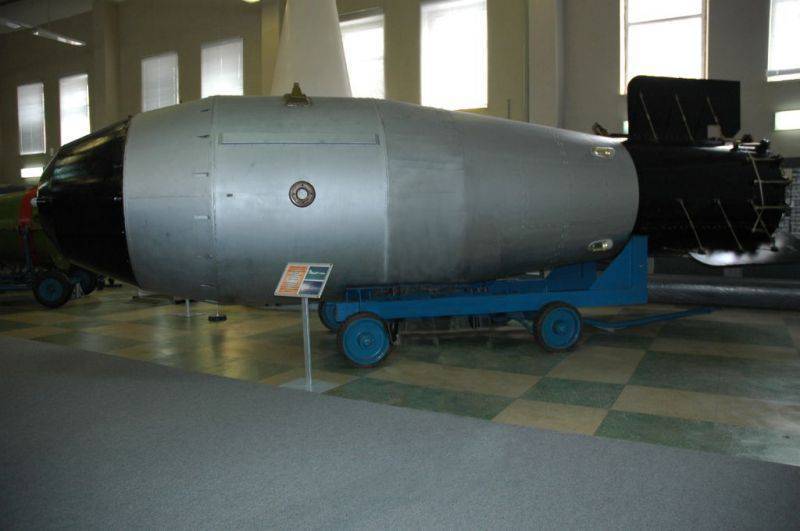
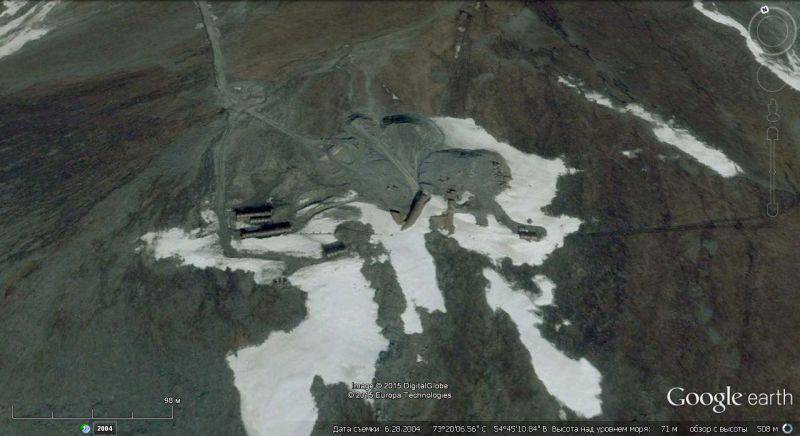
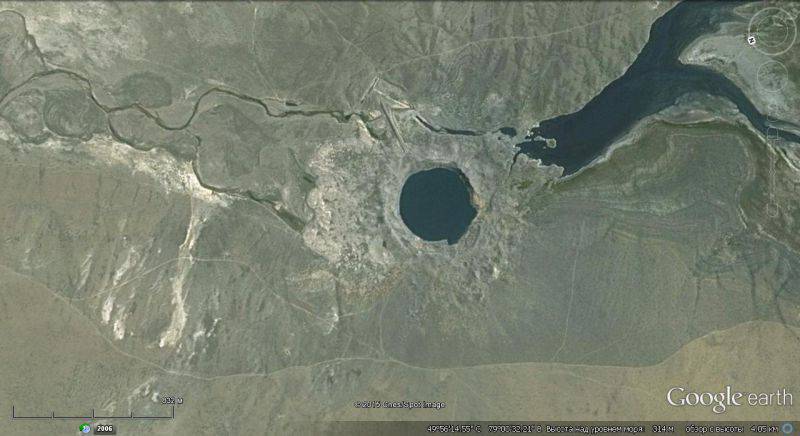
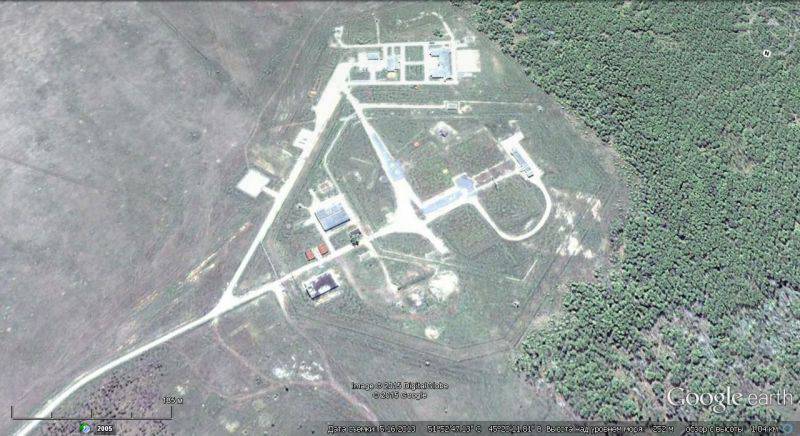
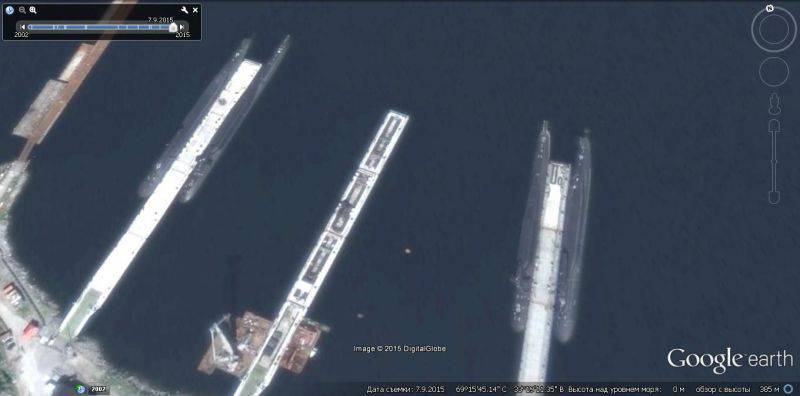
Information